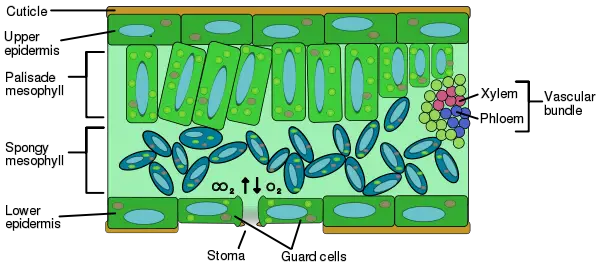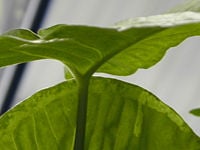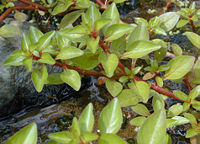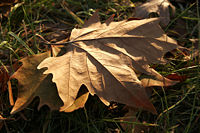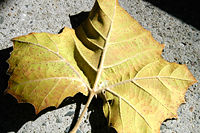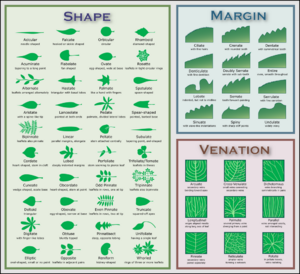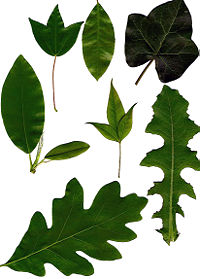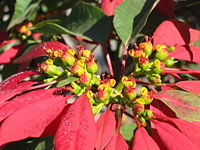Leaf
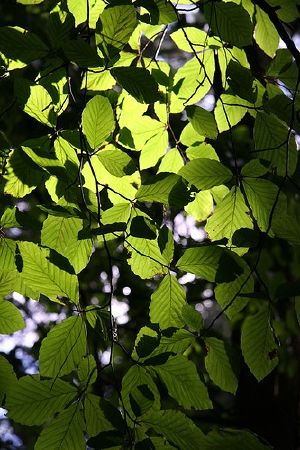
In botany, a leaf is an above-ground plant organ specialized for photosynthesis. For this purpose, a leaf is typically flat (laminar) and thin, to expose the chloroplast-containing cells (chlorenchyma tissue) to light over a broad area, and to allow light to penetrate fully into the tissues.
Leaves are also the sites in most plants where respiration (use of oxygen or the production of carbon dioxide), transpiration (passage of water vapor through the pore or membrane of the leaf), and guttation (oozing of water from the leaves resulting from root pressure) take place.
Leaves exhibit a great deal of diversity in terms of shape, arrangement on the stem, vein arrangement, thickness, and so forth. The angle that they diverge from the stem follows mathematical regularity according to the Fibonacci sequence: 1/2, 2/3, 3/5, 5/8, 8/13, 13/21, 21/34, 34/55, 55/89. This series tends to a limit of 137° 30', an angle known as the "golden angle." (See Arrangement on the stem.)
Just as the xylem and phloem of a plant's vascular system has been compared to the vein and arteries of the human circulatory system, leaves have been compared to human lungs, with both involved in the exchange of gases with the outside environment. In Western religions, this reflects the theological concept of humans as a microcosm of creation (Burns 2006).
Leaves can store food and water, and are modified in some plants for other purposes. The comparable structures of ferns are correctly referred to as fronds.
Leaf anatomy
A structurally complete leaf of an angiosperm consists of a petiole (leaf stem), a lamina (leaf blade), and stipules (small processes located to either side of the base of the petiole). The point at which the petiole attaches to the stem is called the leaf axil. Not every species produces leaves with all of these structural parts. In some species, paired stipules are not obvious or are absent altogether; a petiole may be absent; or the blade may not be laminar (flattened). The tremendous variety shown in leaf structure (anatomy) from species to species is presented in detail below.
A leaf is considered to be a plant organ, typically consisting of the following tissues:
- An epidermis that covers the upper and lower surfaces
- An interior chlorenchyma called the mesophyll
- An arrangement of veins (the vascular tissue).
Epidermis
The epidermis is the outer multi-layered group of cells covering the leaf. It forms the boundary between the plant and the external world. The epidermis serves several functions: protection against water loss, regulation of gas exchange, secretion of metabolic compounds, and (in some species) absorption of water. Most leaves show dorsoventral anatomy: the upper (adaxial) and lower (abaxial) surfaces have somewhat different construction and may serve different functions.
The epidermis is usually transparent (epidermal cells lack chloroplasts) and coated on the outer side with a waxy cuticle that prevents water loss. The cuticle may be thinner on the lower epidermis than on the upper epidermis; and is thicker on leaves from dry climates as compared with those from wet climates.
The epidermis tissue includes several differentiated cell types: epidermal cells, guard cells, subsidiary cells, and epidermal hairs (trichomes). The epidermal cells are the most numerous, largest, and least specialized. These are typically more elongated in the leaves of monocots than in those of dicots.
The epidermis is covered with pores called stomata (singular, stoma), part of a stoma complex consisting of a pore surrounded on each side by chloroplast-containing guard cells, and two to four subsidiary cells that lack chloroplasts. The stoma complex regulates the exchange of gases and water vapor between the outside air and the interior of the leaf. Typically, the stomata are more numerous over the abaxial (lower) epidermis than the (adaxial) upper epidermis.
Trichomes or hairs grow out from the epidermis in many species.
Mesophyll
Most of the interior of the leaf between the upper and lower layers of epidermis is a parenchyma (ground tissue) or chlorenchyma tissue called the mesophyll (middle leaf). This "assimilation tissue" is the primary location of photosynthesis in the plant. The products of photosynthesis are called assimilates.
In ferns and most flowering plants, the mesophyll is divided into two layers:
- An upper palisade layer of tightly packed, vertically elongated cells, one to two cells thick, directly beneath the adaxial epidermis. Its cells contain many more chloroplasts than the spongy layer. These long cylindrical cells are regularly arranged in one to five rows. Cylindrical cells, with the chloroplasts close to the walls of the cell, can take optimal advantage of light. The slight separation of the cells provides maximum absorption of carbon dioxide. This separation must be minimal to afford capillary action for water distribution. In order to adapt to their different environment (such as sun or shade), plants had to adapt this structure to obtain optimal result. Sun leaves have a multi-layered palisade layer, while shade leaves or older leaves closer to the soil, are single-layered.
- Beneath the palisade layer is the spongy layer. The cells of the spongy layer are more rounded and not so tightly packed. There are large intercellular air spaces. These cells contain fewer chloroplasts than those of the palisade layer.
The pores or stomata of the epidermis open into substomatal chambers, connecting to air spaces between the spongy layer cells.
These two different layers of the mesophyll are absent in many aquatic and marsh plants. An epidermis and a mesophyll may be lacking. Instead, for their gaseous exchanges, they use a homogeneous aerenchyma (thin-walled cells separated by large gas-filled spaces). Their stomata are situated at the upper surface.
Leaves are normally green in color, which comes from chlorophyll found in plastids in the chlorenchyma cells. Plants that lack chlorophyll cannot photosynthesize.
Leaves in temperate, boreal, and seasonally dry zones may be seasonally deciduous (falling off or dying for the inclement season). This mechanism to shed leaves is called abscission. After the leaf is shed, a leaf scar develops on the twig. In cold autumns they sometimes turn yellow, bright orange or red as various accessory pigments (carotenoids and anthocyanins) are revealed when the tree responds to cold and reduced sunlight by curtailing chlorophyll production.
Veins
The veins are the vascular tissue of the leaf and are located in the spongy layer of the mesophyll. They are typical examples of pattern formation through ramification.
The veins are made up of:
- xylem, which brings water from the roots into the leaf.
- phloem, which usually moves sap out, the latter containing the glucose produced by photosynthesis in the leaf.
The xylem typically lies over the phloem. Both are embedded in a dense parenchyma tissue (= ground tissue), called pith, with usually some structural collenchyma tissue present.
Leaf morphology
External leaf characteristics (such as shape, margin, hairs, etc.) are important for identifying plant species, and botanists have developed a rich terminology for describing leaf characteristics. These structures are a part of what makes leaves determinant; they grow and achieve a specific pattern and shape, then stop. Other plant parts like stems or roots are non-determinant, and will continue to grow as long as they have the resources to do so.
Leaves may be classified in many different ways, and the type is usually characteristic of a species, although some species produce more than one type of leaf.
Basic leaf types
- Ferns have fronds
- Conifer leaves are typically needle-, awl-, or scale-shaped
- Angiosperm (flowering plant) leaves: the standard form includes stipules, petiole, and lamina
- Microphyll leaves
- Sheath leaves (type found in most grasses)
- Other specialized leaves
Arrangement on the stem
As a stem grows, leaves tend to appear arranged around the stem in a way that optimizes yield of light. In essence, leaves come off the stem in a spiral pattern, either clockwise or counterclockwise, with (depending upon the species) the same angle of divergence. There is a regularity in these angles and they follow the numbers in a Fibonacci sequence: 1/2, 2/3, 3/5, 5/8, 8/13, 13/21, 21/34, 34/55, 55/89. This series tends to a limit of 360° x 34/89 = 137.52 or 137° 30', an angle known mathematically as the "golden angle." In the series, the numerator gives the number of complete turns or gyres until the leaf arrives at the initial position. The denominator gives the number of leaves in the arrangement. This can be demonstrated by the following:
- alternate leaves have an angle of 180° (or 1/2)
- 120° (or 1/3): three leaves in one circle
- 144° (or 2/5): five leaves in two gyres
- 135° (or 3/8): eight leaves in three gyres.
The fact that an arrangement of anything in nature can be described by a mathematical formula is not in itself mysterious. Mathematics is the science of discovering numerical relationships and applying formula to these relationships. The formulas themselves can provide clues to the underlying physiological processes that, in this case, determine where the next leaf bud will form in the elongating stem. However, we can more easily describe the arrangement of leaves using the following terms:
- Alternate â leaf attachments singular at nodes, and leaves alternate direction, to a greater or lesser degree, along the stem.
- Opposite â leaf attachments paired at each node; decussate if, as typical, each successive pair is rotated 90° going along the stem; or distichous if not rotated, but two-ranked (in the same plane).
- Whorled â three or more leaves attach at each point or node on the stem. As with opposite leaves, successive whorls may or may not be decussate, rotated by half the angle between the leaves in the whorl (i.e., successive whorls of three rotated 60°, whorls of four rotated 45°, etc). Note: opposite leaves may appear whorled near the tip of the stem.
- Rosulate â leaves form a rosette ( = a cluster of leaves growing in crowded circles from a common center).
Divisions of the lamina (blade)
Two basic forms of leaves can be described considering the way the blade is divided. A simple leaf has an undivided blade. However, the leaf shape may be one of lobes, but the gaps between lobes do not reach to the main vein. A compound leaf has a fully subdivided blade, each leaflet of the blade separated along a main or secondary vein. Because each leaflet can appear to be a "simple leaf," it is important to recognize where the petiole occurs to identify a compound leaf. Compound leaves are a characteristic of some families of higher plants, such as the Fabaceae.
- Palmately compound leaves have the leaflets radiating from the end of the petiole, like fingers off the palm of a hand. There is no rachis, e.g. Cannabis (hemp) and Aesculus (buckeyes)
- Pinnately compound leaves have the leaflets arranged along the main or mid-vein (called a rachis in this case)
- odd pinnate: with a terminal leaflet, e.g. Fraxinus (ash)
- even pinnate: lacking a terminal leaflet, e.g. Swietenia (mahogany)
- Bipinnately compound leaves are twice divided: the leaflets are arranged along a secondary vein that is one of several branching off the rachis. Each leaflet is called a pinnule. The pinnules on one secondary vein are called pinna; e.g. Albizia (silk tree)
- trifoliate: a pinnate leaf with just three leaflets, e.g. Trifolium (clover), Laburnum (laburnum)
- pinnatifid: pinnately dissected to the midrib, but with the leaflets not entirely separate, e.g. some Sorbus (whitebeams)
- Characteristics of the petiole
- Petiolated leaves have a petiole.
- In peltate leaves, the petiole attaches to the blade inside from the blade margin.
- Sessile or clasping leaves do not have a petiole. In sessile leaves the blade attaches directly to the stem. In clasping leaves, the blade partially or wholly surrounds the stem, giving the impression that the shoot grows through the leaf such as in Claytonia perfoliata of the purslane family (Portulacaceae).
In some Acacia species, such as the Koa Tree (Acacia koa), the petioles are expanded or broadened and function like leaf blades; these are called phyllodes. There may or may not be normal pinnate leaves at the tip of the phyllode.
- Characteristics of the stipule
- A stipule, present on the leaves of many dicotyledons, is an appendage on each side at the base of the petiole, resembling a small leaf. They may be lasting and not be shed (a stipulate leaf, such as in roses and beans); or be shed as the leaf expands, leaving a stipule scar on the twig (an exstipulate leaf).
- The situation, arrangement, and structure of the stipules is called the stipulation.
- free
- adnate: fused to the petiole base
- ochreate : provided with ochrea, or sheath-formed stipules, e.g. rhubarb,
- encircling the petiole base
- interpetiolar : between the petioles of two opposite leaves.
- intrapetiolar : between the petiole and the subtending stem
Venation (arrangement of the veins)
There are two subtypes of venation, craspedodromus (the major veins stretch up to the margin of the leaf) and camptodromous (major veins come close to the margin, but bend before they get to it).
- Feather-veined, reticulate: the veins arise pinnately from a single mid-vein and subdivide into veinlets. These, in turn, form a complicated network. This type of venation is typical for dicotyledons.
- Pinnate-netted, penniribbed, penninerved, penniveined; the leaf has usually one main vein (called the mid-vein), with veinlets, smaller veins branching off laterally, usually somewhat parallel to each other; e.g. Malus (apples).
- Three main veins originate from the base of the lamina, as in Ceanothus.
- Palmate-netted, palmate-veined, fan-veined; several main veins diverge from near the leaf base where the petiole attaches, and radiate toward the edge of the leaf; e.g. most Acer (maples).
- Parallel-veined, parallel-ribbed, parallel-nerved, penniparallel: veins run parallel most the length of the leaf, from the base to the apex. Commissural veins (small veins) connect the major parallel veins. Typical for most monocotyledons, such as Poaceae (grasses).
- Dichotomous: There are no dominant bundles, with the veins forking regularly by pairs; found in Ginkgo and some pteridophytes.
Leaf terminology
Shape
In botany, the following terms are used to describe the shape of plant leaves:
- Acicular: slender and pointed
- Acuminate: tapering to a long point
- Alternate (alternifolia): Arranged alternately
- Bipinnate (bipinnata): Each leaflet also pinnate
- Cordate (cordata): Heart-shaped, stem attaches to cleft
- Cuneate: Triangular, stem attaches to point
- Deltoid: Triangular, stem attaches to side
- Digitate (digitata): Divided into finger-like lobes
- Elliptic (elliptica): Oval, with a short point
- Falcate: sickle-shaped
- Flabellate: Semi-circular, or fan-like
- Hastate: shaped like a spear point, with flaring pointed lobes at the base
- Lance-shaped, lanceolate (lanceolata): Long, wider in the middle
- Linear: Long and very narrow
- Lobed (lobata): With several points
- Obcordate: Heart-shaped, stem attaches to tapering point
- Oblanceolate (oblanceolata): Top wider than bottom
- Obovate: Teardrop-shaped, stem attaches to tapering point
- Opposite (oppositifolia): Leaves opposite one another
- Orbicular: Circular
- Ovate (ovata): Oval, egg-shaped, with a tapering point
- Palmate (palmata): Divided into many lobes
- Peltate (peltata): Rounded, stem underneath
- Perfoliate (perfoliata): Stem through the leaves
- Pinnate (pinnata): Two rows of leaflets
- odd pinnate : pinnate with a terminal leaflet
- paripinnate, even-pinnate : pinnate lacking a terminal leaflet
- Pinnatisect (pinnatifida): Cut, but not to the midrib
- Reniform: Kidney-shaped
- Rhomboid (rhomboidalis): Diamond-shaped
- Rosette: Leaves in close rings
- Round (rotundifolia): Circular
- Sagittate: Arrowhead-shaped
- Spatulate, spathulate (spathulata): Spoon-shaped
- Spear-shaped (hastata): Pointed, with barbs
- Subulate: Awl-shaped
- Sword-shaped (ensiformis): Long, thin, pointed
- Trifoliate, ternate (trifoliata): Divided into three leaflets
- Tripinnate (tripinnata): Each leaflet divided into three
- Unifoliate : with a single leaf
- Whorled: In circles round the stem
Margins (edge)
The leaf margin is characteristic for a genus and aids in determining the species.
- entire: even; with a smooth margin; without toothing
- ciliate: fringed with hairs
- crenate: wavy-toothed; dentate with rounded teeth, such as Fagus (beech)
- dentate: toothed, such as Castanea (chestnut)
- coarse-toothed: with large teeth
- glandular toothed: with teeth that bear glands
- denticulate: finely toothed
- doubly toothed: each tooth bearing smaller teeth, such as Ulmus (elm)
- lobate: indented, with the indentations not reaching to the center, such as many Quercus (oaks)
- palmately lobed: indented with the indentations reaching to the center, such as Humulus (hop)
- serrate: saw-toothed with asymmetrical teeth pointing forward, such as Urtica (nettle)
- serrulate: finely serrate
- sinuate: with deep, wave-like indentations; coarsely crenate, such as many Rumex (docks)
- spiny: with stiff, sharp points, such as some Ilex (hollies) and Cirsium (thistles).
Tip of the leaf
- acuminate: long-pointed, prolonged into a narrow, tapering point in a concave manner
- acute: ending in a sharp, but not prolonged point
- cuspidate: with a sharp, elongated, rigid tip; tipped with a cusp
- emarginate: indented, with a shallow notch at the tip
- mucronate: abruptly tipped with a small short point, as a continuation of the midrib; tipped with a mucro
- mucronulate: mucronate, but with a smaller spine.
- obcordate: inversely heart-shaped, deeply notched at the top
- obtuse: rounded or blunt
- truncate: ending abruptly with a flat end, that looks cut off
Base of the leaf
- acuminate: coming to a sharp, narrow, prolonged point
- acute: coming to a sharp, but not prolonged point
- auriculate: ear-shaped
- cordate: heart-shaped with the norch away from the stem
- cuneate: wedge-shaped
- hastate: shaped like an halberd and with the basal lobes pointing outward
- oblique: slanting
- reniform: kidney-shaped but rounder and broader than long
- rounded: curving shape
- sagittate: shaped like an arrowhead and with the acute basal lobes pointing downward
- truncate: ending abruptly with a flat end, that looks cut off
Surface of the leaf
The surface of a leaf can be described by several botanical terms:
- farinose: bearing farina; mealy, covered with a waxy, whitish powder
- glabrous: smooth, not hairy
- glaucous: with a whitish bloom; covered with a very fine, bluish-white powder
- glutinous: sticky, viscid
- papillate, papillose: bearing papillae (minute, nipple-shaped protuberances)
- pubescent: covered with erect hairs (especially soft and short ones)
- punctate: marked with dots; dotted with depressions or with translucent glands or colored dots
- rugose: deeply wrinkled; with veins clearly visible
- scurfy: covered with tiny, broad scalelike particles.
- tuberculate: covered with tubercles; covered with warty prominences
- verrucose: warted, with warty outgrowths
- viscid, viscous: covered with thick, sticky secretions
Hairiness (trichomes)
Leaves can show several degrees of hairiness. The meaning of several of the following terms can overlap.
- glabrous: no hairs of any kind present
- arachnoid, arachnose: with many fine, entangled hairs giving a cobwebby appearance
- barbellate: with finely barbed hairs (barbellae)
- bearded: with long, stiff hairs
- bristly: with stiff hair-like prickles
- canescent: hoary with dense grayish-white pubescence
- ciliate: marginally fringed with short hairs (cilia)
- ciliolate: minutely ciliate
- floccose: with flocks of soft, woolly hairs, which tend to rub off
- glandular: with a gland at the tip of the hair
- hirsute: with rather rough or stiff hairs
- hispid: with rigid, bristly hairs
- hispidulous: minutely hispid
- hoary: with a fine, close grayish-white pubescence
- lanate, lanose: with woolly hairs
- pilose: with soft, clearly separated hairs
- puberulent, puberulous: with fine, minute hairs
- pubescent: with soft, short and erect hairs
- scabrous, scabrid: rough to the touch
- sericeous: silky appearance through fine, straight and appressed (lying close and flat) hairs
- silky: with adpressed, soft and straight pubescence
- stellate, stelliform: with star-shaped hairs
- strigose: with appressed, sharp, straight and stiff hairs
- tomentose: densely pubescent with matted, soft white woolly hairs
- cano-tomentose: between canescent and tomentose
- felted-tomentose: woolly and matted with curly hairs
- villous: with long and soft hairs, usually curved
- woolly: with long, soft and tortuous or matted hairs
Adaptations
In order to survive in a harsh environment, leaves can adapt in the following ways:
- Hairs develop on the leaf surface to trap humidity in dry climates, creating a large boundary layer to lessen water loss
- Leaves rustle to move humidity away from the surface reducing the boundary layer resistance between the leaf and the air.
- Plant prickles are modified clusters of epidermal hairs
- Waxy leaf surfaces form to prevent water loss
- Small, shiny leaves to deflect the sun's rays
- Thicker leaves to store water (e.g. rhubarb)
- Change to spines instead of laminar (blade) leaves (e.g. cactus)
- Shrink (to phyllodes) or disappear (with the appearance of cladodes), as photosynthetic functions are transferred to the leaf stem (Acacia species)
- Change shape to deflect wind or reduce wind resistance
- Leaves to trap insects (e.g. pitcher plant)
- Change to bulb parts to store food (e.g. onion)
- Produce aromatic oils to deter herbivores (e.g. eucalypts)
- Protect as spines, which are modified leaves
- Change color to attract insects, birds (e.g. Poinsettia)
ReferencesISBN links support NWE through referral fees
- Burns, C. P. E. 2006. Altruism in nature as manifestation of divine energia. Zygon 41(1): 125-137.
- Dickison, W. C. 2000. Integrative Plant Anatomy. San Diego: Elsevier Press. ISBN 0122151704
- Mauseth, J. D. 2003. Botany: an introduction to plant biology. James and Bartlett Publishers. ISBN 0763721344
- Raven, P. H., and G. B. Johnson. 1996. Biology 4th ed. Wm. C. Brown Publishers. ISBN 0697225704
Credits
New World Encyclopedia writers and editors rewrote and completed the Wikipedia article in accordance with New World Encyclopedia standards. This article abides by terms of the Creative Commons CC-by-sa 3.0 License (CC-by-sa), which may be used and disseminated with proper attribution. Credit is due under the terms of this license that can reference both the New World Encyclopedia contributors and the selfless volunteer contributors of the Wikimedia Foundation. To cite this article click here for a list of acceptable citing formats.The history of earlier contributions by wikipedians is accessible to researchers here:
The history of this article since it was imported to New World Encyclopedia:
Note: Some restrictions may apply to use of individual images which are separately licensed.
